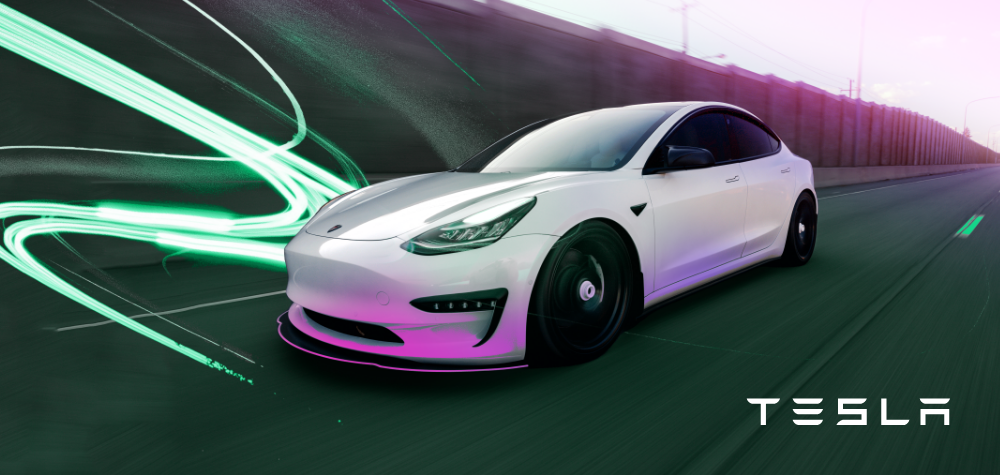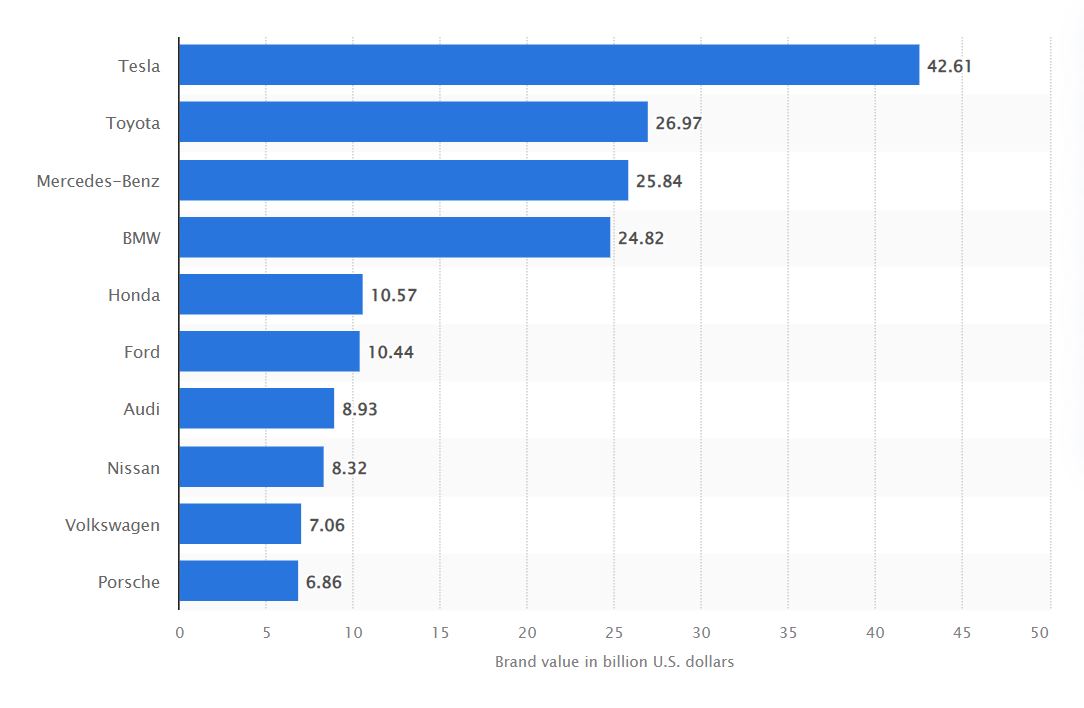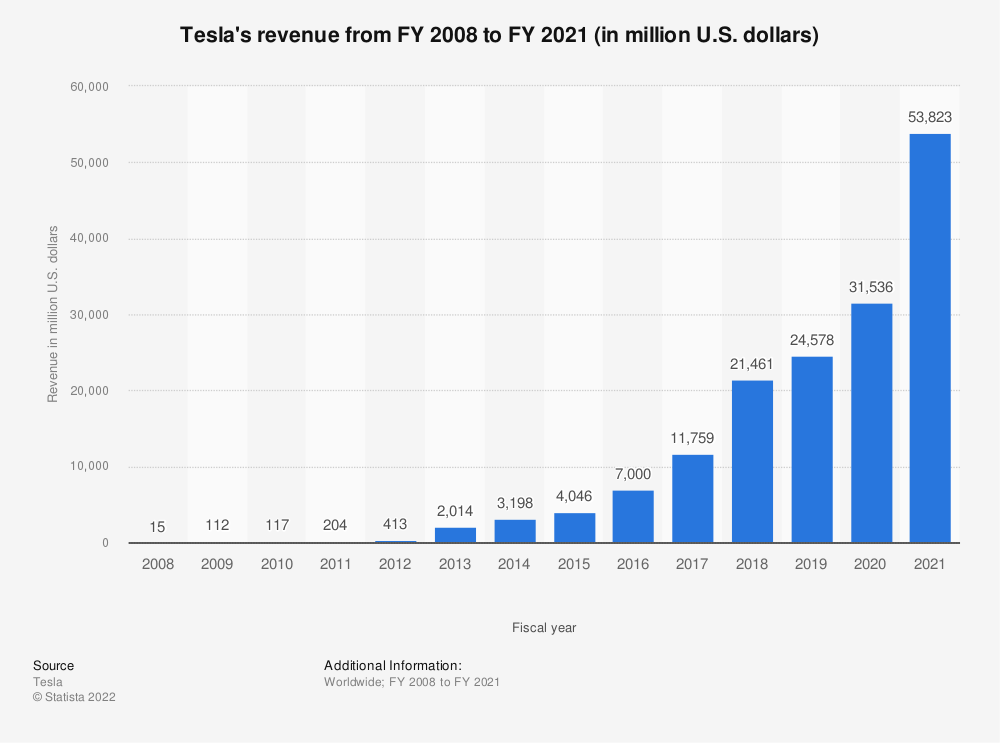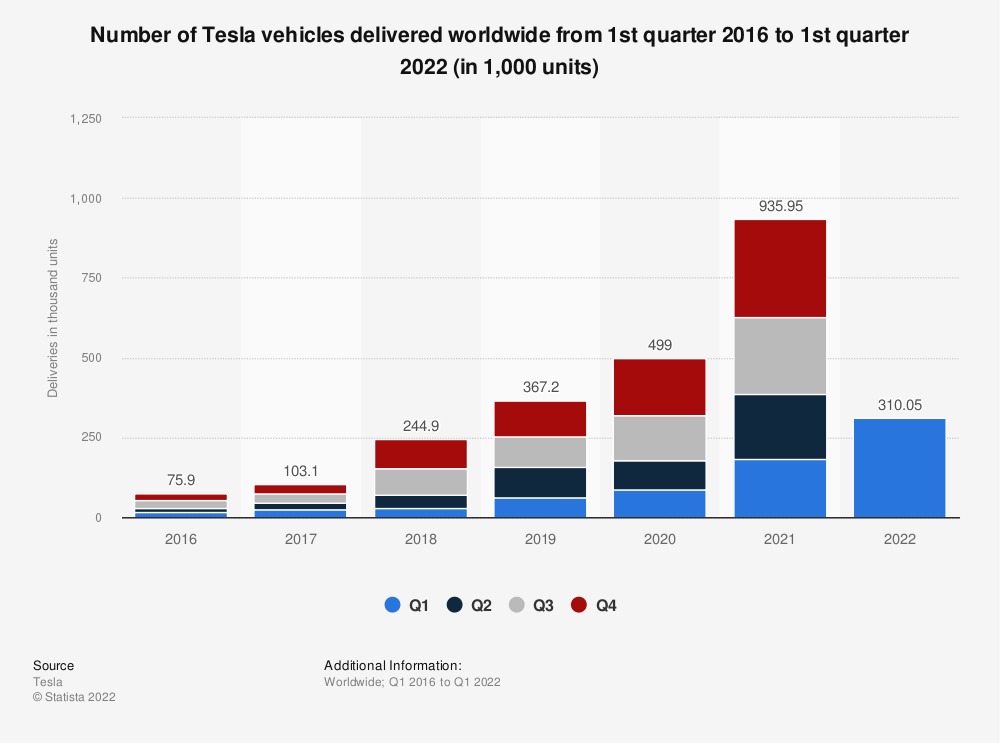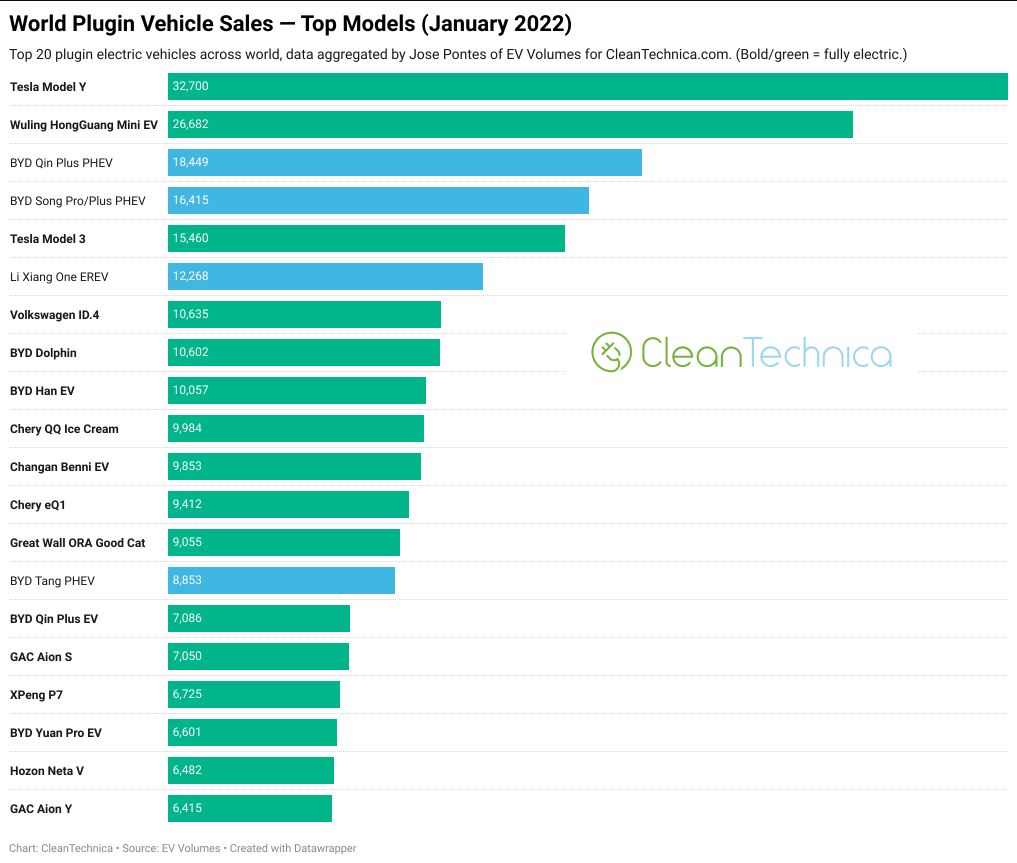In 2020, Tesla celebrated 10 years as a public company. More than just an automaker, the Tesla brand has become synonymous with electric cars and sustainable living, propelled in a short time to the level of auto brand recognition matched only by the world’s most famous and veteran car companies, such as GM and Nissan.
The rising public interest and demand for electric-powered vehicles can be attributed to Tesla and the visionary spirit of its founder and CEO Elon Musk, whose other ventures include space travel.
In 2021, Tesla brand value was estimated at $42.61 billion, making it the most valuable automotive brand worldwide, beating even the long-standing popular Japanese, European and US brands like Toyota, Mercedes Benz, Honda and Ford.
Source – Statista
In a 2006 blog, Tesla CEO Musk outlined his long-term goal to “to help expedite the move from a mine-and-burn hydrocarbon economy towards a solar electric economy.” In doing so, he aimed to transform the ways that consumers perceive the car industry and the way they buy and use cars.
Let’s take a dive into Tesla’s target demographics and see who are Tesla’s customers and Tesla brand positioning in different segments in the US and global auto market.
Who is Tesla’s target market?
While Tesla aims to alter the energy economy, the fact remains that electric cars are still a relatively expensive and therefore ‘luxury’ product. The main reasons that consumers are interested in purchasing an electric vehicle are environmental concerns surrounding the use of fossil-fuel based gasoline, and economic concerns about the price of gas.
At the current time, the Tesla target market segmentation reflects a relatively small share of the overall car market, principally affluent, highly educated professionals and families with solid income whose lifestyle is built around reducing their carbon footprint.
Since the 2008 launch of Tesla’s first model, the Roadster, the company continues to work towards the broader goal of potential Tesla market segments, and making electric cars accessible and affordable to a wide customer base.
Tesla Target Market Segmentation and Audience
In 2021, Tesla’s revenue increased by an incredible 71% compared to the previous year, reaching nearly $54 billion.
Source – Statista
This strongly reflects the brand’s marketing success among the Tesla target audience. By breaking down the target market into various segmentation perspectives and conducting a demographic audience analysis, it is possible to gain an understanding of how Tesla continues to generate such powerful brand perception and sales.
Tesla Demographic Segmentation
The average Tesla customer profile has a median age of 54 years, mainly male customers, though there is a smaller target demographic of females that are interested in Tesla cars. The Tesla target demographic is largely established families with kids, including younger children or teenagers, and they are mostly professionals, executives, senior managers or hold other high-income positions.
The average income of a Tesla owner for the entire household is $143,177 for the Model X and a slightly lower $128,140 for the Tesla Model 3.
Tesla Geographic Segmentation
Tesla cars are popular in North America, Europe and Asia, with vehicle deliveries reaching over 627,000 units in the first three quarters of 2021, representing an increase of more than 16 percent over sales in the whole of 2020.
Source – Statista
China is a fast growing geographic segment for Tesla, with sales more than double in 2021 compared to the previous year, and representing a fifth of global sales. However, the US is by far the biggest consumer segment for Tesla, representing nearly half of total worldwide sales for the brand in 2021.
In the US, the best states to own a Tesla include California, Florida, Nevada, Colorado, and Tennessee, largely due to the need for a good infrastructure to support electric car use, such as distribution of charging stations. In addition, Teslas tend to be popular in sunny, warm states where the weather maximizes the life of the battery, as well as states whose tax structures are favorable to electric car ownership.
Tesla Behavioral Segmentation
In Tesla consumer behavior, a big consideration is the social status afforded by ownership of an electric car. In addition to the environmentally friendly perception, Tesla is also seen as a long-term, cost efficient investment. For the Tesla audience, switching cars in a couple of years is not an option. They aim to hold onto their Tesla car for many years ahead.
With the median age of Tesla buyers being 54 years, this older and financially established Tesla market demographic can afford to consume luxury brands, not just in their choice of car but in other product segments too. In fact, 77% of Tesla Model S owners earn over $100,000 a year.
Tesla Psychographic Segmentation
The Tesla target market is characterized as early adopters of technology, with a forward-thinking and image conscious psychological make-up. They are highly driven, with character traits defined as “Aspirer, Succeeder, Explorer, Reformer, and Environmentally cautious.” This is evident in their professional success and high earner status.
Tesla marketing strategy – Key Elements
In contrast to traditional marketing methods typically used by auto companies, such as TV commercials and expensive Super Bowl spots, Tesla brand communication focuses on the user experience.
This includes tactics such as customer referral programs, influencer marketing and organic social media, all of which enable the company to achieve enormous success with far smaller marketing budgets compared to prominent car brands.
Tesla CEO Elon Musk is very vocal about his antithesis to advertising. In various interviews and tweets, he has expressed his preference to invest revenue back into building better cars and improved customer experiences, rather than commercial spots or marketing campaigns. As a result, the Tesla go to market strategy has been touted as a “$0 marketing budget”, even as it continues to increase sales and market share.
The personality of Elon Musk has been essential to driving Tesla brand recognition, with tweets that drive online buzz and his feature at the top of the list of Time magazine’s Top Influential People in 2013.
In addition, Tesla succeeds because it positions itself not just as a car, but as a lifestyle and philosophy that extends to every aspect of the customer relationship, including its Tesla Centers, designed to circumvent dealership restrictions and give a faster, better sales and service experience for customers.
In order to deliver better customer experiences, it is important to understand the typical customer profile. A glance at Start.io data about hybrid and electric car owners in Houston, for example, shows that they are mostly male, aged 25 to 34 years, and spend time at the gym and Walmart.
Hybrid or Electric car owners in United States
In Q4 2021, just over 240,000 hybrid and plug-in hybrid electric vehicles were sold in the US. By 2035, EVs are predicted to make up 45% of the total US auto market.
Despite this impressive rise, a recent report noted that 18% of people who buy electric cars eventually revert back to gas-powered vehicles. If the EV is a hybrid model, the owner is 20% more likely to prefer to return to gas-run options. This is largely due to difficulties and inconvenience of having to charge the car. Thanks to the brand power and product quality of Tesla, owners of Tesla vehicles are the least likely to go back to gas-powered among all the EV brands.
In 2021, Tesla Model Y was the best selling plug-in electric car, with sales of over 172,000 units.
As of 2022, the Tesla Model Y is the best selling electric car worldwide, followed by its closest competitor, the Wuling Hongguang Mini EV, the Chinese made model that only came on the market in 2020.
Source – CleanTechnica
Consumer Insights and Audiences
Tesla demographic segmentation is an example of how to analyze and understand the consumer profile and develop marketing messages and campaigns that resonate with the target audience. This is vital to build brand awareness effectively and become the success story that is still unfolding for the electric car brand.
At Start.io, the Consumer Insights and Audiences hub provides a deep dive into thousands of mobile consumer segments. Simply filter by interest, country, or city to uncover valuable granular insights about your target audience, whether EV and hybrid car owners, or any other interest or lifestyle niche, and achieve better results from your mobile campaigns.
Tesla Motors FAQs
How is Tesla impacting the automotive marketplace?
While traditional automakers are struggling with sagging sales and supply chain concerns, Tesla is beating its own sales records, year on year. Apart from the rise in sustainability awareness and consumer demand for eco-friendly products, this success is also attributed to Tesla’s innovative technological, logistical and management capabilities that ensure the company consistently provides high performance in both product and service.
What motivates people to buy a Tesla?
The demographics of Tesla owners is made up mainly of consumers who are passionate about reducing their carbon footprint or are interested in the gasoline cost savings. Another aspect of Tesla’s appeal is the social status that it affords, based on its image as an environmentally friendly, highly desirable luxury brand.
While the consumer segment who buys Tesla today are mostly affluent, high-income families, the brand aims to make electric cars affordable for all.
How long do Tesla cars last?
Tesla positions itself as a long-term purchase, offering a battery lifetime of 300,000 to 500,000 miles, which equates to an average of 21 to 35 years for the typical driver! Tesla is building its brand identity as having a lifetime relationship with its customer base.
What are Tesla's best-selling models?
In 2021, the Tesla Model Y and Tesla Model 3 were the best-selling models for the brand in the US, and appear to be among the top 20 car models sold in the US, holding positions 17 and 19 respectively.
In Europe, the Tesla Model 3 was the 17th top selling car during 2021, and also held the impressive number 1 spot as the top selling model in the mid-size car category.
